Getting Started
What To Look For When Purchasing a Cage
The cage that your bird requires depends on your bird's species. Below is an overview on cage features that you should have in mind when you select a cage.
The size of the cage
The very general rule of thumb to determine if the size of a cage is adequate for a single bird to live in comfortably is to make sure that the width of the cage is at least three times the length of the bird's wing span when fully extended; this ensures adequate room for the bird to move around. This rule should only be applied to get a rough estimate to see if the cage you hold in interest is worth further investigation.
The standard minimum cage size for a single bird for each type of bird is:
- For budgies: 16"L x 12" W x 20"H
- For canaries: 16"L x 16"W x 16"H
- For cockatiels: 20"L x 20"W x 24"H
- For finches: 16"L x 16"W x 16"H
- For love birds: 18"L x 18"W x 18"H
- For parrotlets: 18"L x 18"W x 24"H
It is strongly recommended that you try to buy a cage that surpases these miniumum dimension. To buy a cage slightly smaller than the sizes listed above may cost a couple dollars more - but really, what is a couple of dollars more? If you decide that you want to keep a bird as a pet, you must not be cheap on necessary things. Consider the following points on why you should invest in a larger cage:
-
If the cage is too small, your bird will at some time get injured. In the wild, there are no physical barriers for our birds (such as cages). If they want to do something, such as perform flips, they will try to do it regardless of the size and if the cage is too small, only injury will persue. Then, you would have to take your bird to a vet and vet bills do not come in small digits. In the end, you would have saved more if you had spent just a couple more dollars to get a slightly larger cage.
-
Most people want birds, aside from their obvious cute appeal, because they are entertaining. If you buy a cage just big enough for your bit to stand in, and perhaps move back and forth on the perch a couple of inches, you will end up with a very inactive and unhappy bird. Behavioral problems will ensue , such as biting and screaming, and taming will be next to impossible. It is sad when people buy small cages, end up with a very "unloving" bird and then blame it on the bird's personality.
-
Buying a larger cage allows you to be able to house another bird should you succumb to a cute face that you could not resist or decide that you would like another companion for your bird. Again, investing a few extra bucks now will save you a whole lot more later because if the cage is large enough, you won't end up having to buy another cage for the new-comer.
- Remember that you will still have to place water and food cups and also toys in the cage as well, and they also require room.
In summary for this section: 1) If the cage is smaller than the listed dimesions, forget it and move on to another model. 2) Buy as big of a cage as you can afford that will fit in your home.
Shape
Be cautious with the dimensions. Some cages are so poorly designed, that although their dimension is relatively large, the actual space that is left for your bird to live in is too small. Consider the photo below. The dimension of this cage is roughly 20"x20"x32". So great, it exceeds the minimum dimension for a single budgie and therefore it would make a good home? Wrong! This is bad cage design. Despite the dimension, you will note that the tiel has only one (and possibly another smaller perch can be squeezed in the top tower portion) to stand on and his room is seriously limited.
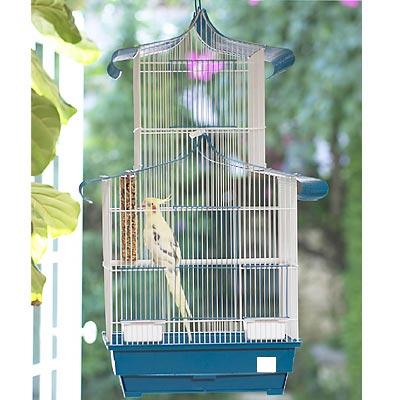
Another poorly designed cage is this photo below. You will note that the "roof" takes up so much room that there is only a small cubical for the bird to actually live in.
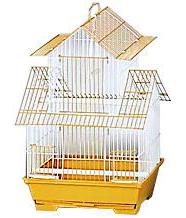
There are countless cages that are badly designed, and unfortunately manufacturers keep producing them because many people who don't know any better think decorative cages are more appealing. Don't forget that your bird's comfort should come first. Some cages are unsuitable for any type of bird (even finches and canaries) because the actual space to move around in is so small. The two cages above are made by respectable pet companies whose logo has been erased for legal purposes, but it just goes to show that you should not just buy a cage because it is made from a good brand name.
The standard cage shape for each type of bird is:
-
For budgies, lovebirds, and parrotlets: rectangular shapes are best. Although they do hop up and down vertically, they prefer to fly horizontally so a horizontally long cage or a rectangular cage is best suited for their comfort. There should be minimal curved surfaces since they love climbing on bars. They will climb bars, even if it is curved or bent, and this will cause strain on his feet.
-
For cockatiels: squared or vertically long cages are best. Avoid minimum curved surfaces for the same reason listed above.
-
For finches and canaries: either horiztonally or vertically long cages are fine. They are hoppers, rather than climbers, so curved surfaces are acceptable.
-
Round cages should be avoided for all species since they can make your bird feel unnecessary stress. Having corners in the cage is said to make birds feel more secure, because the corner feels like a place to retreat to hide from danger.
Below is a photo of a cage with curved surfaces.
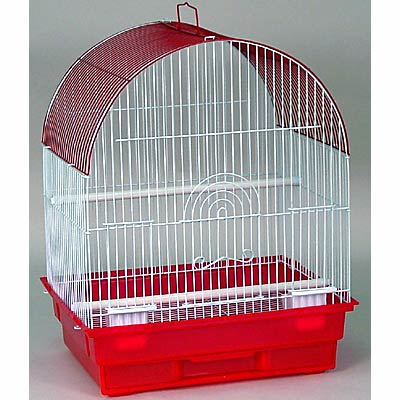
Bar Spacing
Bar spacing for budgies, canaries, finches, lovebirds, and parrotlets should be 1/2 inches. Any smaller or larger spacing proves to be a challange to their climbing abilties - in particluar, strained feet. Larger spacing can also prove hazardous because they can escape through cage bars! Unfortuately, some unsuccessful attempts to escape can lead to death - for instance, if the bird some how manages to squeeze his head through but not the rest of his body. For this very reason, you should also take the time to check that the bars are not flimsy.
Cockatiels require larger bar spacing because they have larger feet. It is recommended that cockatiel cages have 5/8 inch bar spacing. Any smaller bar spacing tend to cause tears in the cockatiel's tail.
Material
The latest cages are made of acrylic. They have their pros and cons. Their main con is that they tend to be much more pricier, the main pro is that they are so much easier to clean (a damp towel is all that is needed to wipe these cages spotless). However, the traditional wired cages are still the more popular choice. when buying wired cages, make sure that it is zinc free. The most common type of wire containing zinc is galvanized wire. Galvanized wires are iron wires coated with zinc to slow down corrosion (rust). Actually, it is the zinc that gets rusted and saves the iron from rusting.
When birds climb on bars, they use their beaks to grip and steer them. If the metal bars contain zinc, the bird will be ingesting small amounts each time he is climbing. Over time, these ingested amounts accumulate and poison the bird. Zinc poisioning primarily cause liver and pancreas destruction. If not treated, the obvious result is death. Read more about zinc poisioning in our health section.
If you chose to purchase a wire cage, check to see that there is no paint peeling off (even if there is a speck of paint chipped off, the sharp eyes of a curious bird will find it and will contently chew the paint off leaving one very sick bird and an unappealing cage). Eating paint is also another way to obtain zinc posioning - this is known as acute zinc poisoning.
Wire cages are highly recommended for budgies, lovebirds, cockatiels, parrotlets, or any other small hooked bills. These birds, especially parrotlets, are heavy chewers and only metal cages can endure their destructive beaks. Never try to house any of these birds in wooden or bamboo cages (photos of such cages are shown below), they will chew through the bars in no time.
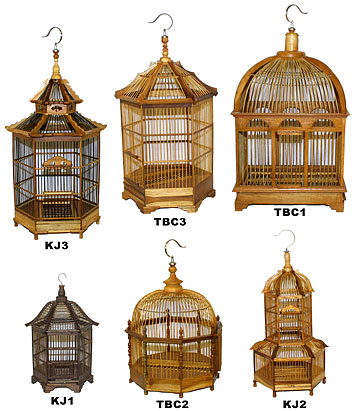
These bamboo or wood-made cages can be used to house finches and canaries because these birds are not aggressive chewers - they are soft bills rather than hooked bills.
Safety Issues
There are many designs for doors available. Not all of them are safe. Doors that swing sideways or swing down is recommended. A couple of years ago, guillotine-styled doors (the ones that slide up and down) were extremely popular because they looked cool. However, these types of doors have been known to cause many bird injuries because they get jammed and don't always open or close properly, giving way for accidents and providing an escape route for the bird. The paint around the rim of these doors would peel off easily from the constant friction of metal on metal upon opening and closing. This led to many incidences of zinc and lead posioning. These types of doors are seldom made now, but there are cages out there that still contain these doors –be aware!
Also, make sure that the cage door is big enough for the bird to enter/exit easily and that your hands can fit in there easily as well. Place your hand straight and vertically and see if your hands can slip through the cage bars. If they can, the metal is too flimsy and will certainly allow the bird to escape. Run your fingers over the cage thoroughly and check to see that there are no sharp cuts, rust, or broken bars.
Tray and grate
Check to see that the cage comes with a sliding tray. If the cage does not have this feature, do not buy the cage. Sliding trays make life easier when it is time to clean their droppings and all else they have discarded. People tend to get lazy when cages do not have sliding trays and tend to not clean the cage often, this unsanitary living condition will lower the bird's life span greatly. For instance, most budgies have the potential to live up to 15 years of age but most die within the first 5 years due to things like unsanitary living conditions and accidents. Another feature, which is not essential, are bars/grate at the bottom of the cage right above the sliding trays. Some birds have a nasty habit of eating their feces and debris, these bars prevent the bird from having access to such things and also prevents the bird from chewing up the newspaper/tray coverings.
Stands and hooks
Some cages come with stands and some come with a big hook at the top. Stands are useful because birds feel more confident if they are higher up so they can have a birds view (ironic lol) of the room. Stands are also useful to keep the cage out of reach of young children or other pets.
Cages with hook suggest that they should be hanged from the ceiling. Hanging cages is recommended only for canaries and finches. It should be avoided for all other birds because every movement would essentially cause the cage to shake and swing. Some of these hooks are not as strong or sturdy as they look. Also, the higher up the cage, the more mess that will spread around the room and hence the more time you have to spend daily to clean up after your bird. If you are sure that you want to hang your cage, check and double check that the hook is sturdy. As a safety precaution, you should chain the bars on either side of the hook and attach the chain to the ceiling. This way, if the hook gives away, the chains can act to temporarily hold up the cage until you become aware that the hook is defective.
Cage related issues and accessories
To prevent seed hulls from flying around the room, “seed guard covers” are available in most pet stores and are sized to fit most cages. They come in a wide variety of colors.
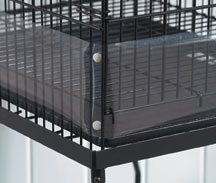
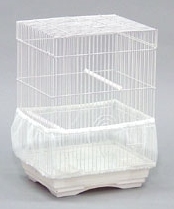
Cage covers are also something to consider. Many pet stores offer this item, but you can just use a blanket, cloth, or towel you have at home. Make sure that the cage cover is airy so that the bird will not suffocate when the cage is covered. A cage covering will keep the bird calm during time stress and illness and allow the bird to have privacy and a feeling of security during sleep. It also helps to prevent the bird's sleep from being disturbed if something rustles or moves during the night.
